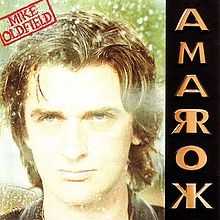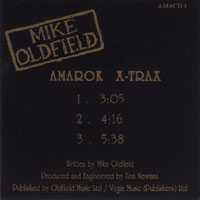Amarok (Mike Oldfield album)
| Amarok | ||||
|---|---|---|---|---|
 | ||||
| Studio album by Mike Oldfield | ||||
| Released | 14 June 1990 | |||
| Recorded | September 1989 – March 1990 | |||
| Genre | World, progressive rock | |||
| Length | 60:02 | |||
| Label | Virgin | |||
| Producer |
Tom Newman Mike Oldfield | |||
| Mike Oldfield chronology | ||||
| ||||
| Professional ratings | |
|---|---|
| Review scores | |
| Source | Rating |
| Allmusic | |
Amarok is Mike Oldfield's 13th album, and was released in 1990. Oldfield originally conceived it as an "angry, protest album", showcasing his musical technique.[2] It is presented as a single sixty-minute track of continuous, uninterrupted but constantly changing music.
Background
Disagreements with Virgin and marketing
Oldfield's relationship with Virgin Records had become increasingly fraught. As a result of ongoing arguments about his contract terms, royalties and advances he decided to create an album designed to both please his fans, and annoy executives at Virgin. Virgin had been trying to convince Oldfield to release a sequel to Tubular Bells, possibly because of the cachet associated with the name, particularly as Oldfield's contract was nearing its end, with three albums left to deliver to the company.
Amarok was designed as a single piece, which made it more difficult for Virgin to produce a section for radio-friendly airplay or single release. Given its length of approximately one hour, it was also extremely unlikely the album could ever be played on popular radio. Oldfield has never performed the piece live in its entirety, though he has played excerpts; excerpts have also appeared on artist "best-of" collections and samplers.
Oldfield had expressed his displeasure at Virgin's lack of promotion of his works on a number of occasions, and Amarok can easily be seen as his riposte to their perceived indifference: an almost unmarketable album that still showcased his talent as a composer and performer. Oldfield did attempt to generate publicity for the album himself by offering a prize of £1000 of his own money to the first person to find the "secret message" hidden within it,[3] although the competition received relatively little coverage and its impact on sales was seemingly negligible. The secret message was a sequence of Morse code found 48 minutes into the piece, spelling out "FUCK OFF RB" in reference to Virgin's Richard Branson, the man who had first signed him.
Amarok, along with Heaven's Open (Oldfield's final album for Virgin) can be seen as an emphatic and dismissive farewell to the record company. In a parody of the spoof listening instructions on the sleeve of Tubular Bells, the album's back cover reads: " HEALTH WARNING – This record could be hazardous to the health of cloth-eared nincompoops. If you suffer from this condition, consult your Doctor immediately ". In the end, Oldfield did not release his sequel to Tubular Bells until he joined Warner.
In Australia the album was released in a double pack with Tubular Bells.[4]
Instrumentation
Oldfield's previous works featured the artist playing a wide variety of instruments. This continued with Amarok, including (in the spirit of techniques such as bricolage and the ethos of Musique Concrète) a number of items such as shoes, spoons, a Hoover vacuum cleaner and the "contents of aeromodeller's toolbox". Though tubular bells are used on the album, they are listed as "long thin metallic hanging tubes" in the liner notes.
The work has many influences from African music, mainly through the use of both vocal and percussion elements.
Comparison to Ommadawn
Many fans do claim that Amarok is to be considered "Ommadawn II. Oldfield himself has said as much: "It's not Tubular Bells II; if anything, it's Ommadawn II".[5] Many of the same people that were involved in the creation of Ommadawn: Jabula, Clodagh Simonds, Bridget St John and Paddy Moloney also appear again.
In addition, William Murray, who co-wrote the song "On Horseback" for Ommadawn, photographed the Amarok cover photo and wrote the short story included in the liner notes. Murray used David Bailey's Ommadawn cover photograph as an inspiration and Tom Newman created the metal lettering that accompanies the photograph on the album cover.
Oldfield has said that Amarok was an experiment to see if he could again create an album without the aid of computers, which he had used more increasingly in his work. He said that he wanted to focus more on the musicianship, playing all of the instruments himself, by hand.[6][7] However, slightly contrarily, he has also discussed the role that Amiga computers had in the album's creation.[8]
Live performance
Although Oldfield has never performed the work live in its entirety, a duo comprising American pianist Gus Fogle and bassist Jason Miller performed the piece in April 2012,[9] after it had been transcribed note for note by Welsh composer and arranger Ryan Yard.[10]
Meanings of the title
Of the album's name, Oldfield has said: "It doesn't have a real meaning but it's similar to many Gaelic words, like those for morning or happy. And if you split the letters up, you get Am-a-rok... it could mean: am a rock. Maybe that implies I don't want to change anything by following trends."[6]
However, a number of other theories as to the name's meaning have been suggested:
- "Amaroq" is an Inuktitut word for "wolf". In particular, Amarok is the name of a giant wolf in Inuit mythology, reputed to hunt down lone travellers, and is used by parents in stories to frighten children. A wolf is heard in the album.
- "Amárach" is an Irish Gaelic word for "tomorrow." It is pronounced with a long second 'a'.
Quotes
| “ | I am told that when men hear its voice, it stays in their ears, they cannot be rid of it. It has many different voices: some happy, but others sad. It roars like a baboon, murmurs like a child, drums like the blazing arms of one thousand drummers, rustles like water in a glass, sings like a lover and laments like a priest... | ” |
| —William Murray, From the short story included in the liner notes.[11] | ||
Lyrics excerpts
- The "Sondela" finale of "Africa III" (from 58:44 to 60:02, the end), sung in the Xhosa language:
- " Sondela / uSomandla / sukuma / wena / obengezela. "
- Come closer / the Almighty / arise / you / shining one.
- (Come closer to us, o Almighty: arise, you who shines.)
Track listing
The album-long track and its 'movement' names:
- "Amarok" – 60:02
|
|
Personnel
- Mike Oldfield – acoustic bass guitar, acoustic guitar, banjo, bass guitar, bass whistles, bouzouki (misspelled in the liner notes as "bazouki"), bell tree, bodhran, bowed guitar, cabasa, classical guitar, electric guitars, Farfisa, Lowrey and Vox organs, Flamenco guitar, glockenspiel (misspelled in the liner notes as "glockenspeil"), high-string guitar, jaw harp, kalimba, mandolin, marimba, melodica, Northumbrian bagpipes, penny whistles, percussion, piano, psaltery, rototom, sitar guitar (a Coral electric sitar), spinet, timpani, tubular bells (listed as "long thin metallic hanging tubes"), twelve-string guitar, ukulele, violin, vocals, and wonga box.
- Janet Brown – voice of "Margaret Thatcher"
- Jabula – African choir and percussion
- Paddy Moloney – tin whistle
- Clodagh Simonds – vocals
- Bridget St John – vocals
- Tom Newman – producer and engineer.
Album promo samplers
Amarok Sampler
Amarok Sampler is a promotional CD-Maxi released in Germany in May 1990 including 5 excerpts from the album, with catalogue number 663,271,000.
- "Amarok" (3:09) excerpt I
- "Amarok" (3:22) excerpt II
- "Amarok" (9:30) excerpt III
- "Amarok" (1:53) excerpt IV
- "Amarok" (2:29) excerpt V
Amarok X-Trax

Amarok X-Trax is the name of two promotional CD-Maxis, one was issued in UK with catalogue number AMACD 1DJ, and one was given away free with W H Smith's in-store magazine Insight, with catalogue number AMACD 1. The WH Smith version included I, II & V from AMACD 1DJ.
- "Amarok" (3:05) excerpt I
- "Amarok" (4:16) excerpt II
- "Amarok" (3:47) excerpt III
- "Amarok" (5:18) excerpt IV
- "Amarok" (5:38) excerpt V
Charts
The album did not chart very highly, but managed to enter the top 50 in various European countries.
| Chart (1990) | Position |
|---|---|
| Austrian Albums (Ö3 Austria)[12] | 26 |
| German Albums (Offizielle Top 100)[13] | 16 |
| Dutch Albums (MegaCharts)[14] | 66 |
| Swedish Albums (Sverigetopplistan)[15] | 50 |
| Swiss Albums (Schweizer Hitparade)[16] | 30 |
References
- ↑ Amarok review at AllMusic
- ↑ "Mike Oldfield: 10 Favourite Tracks". Mojo Magazine. November 1998. Retrieved 26 March 2014.
- ↑ "Interview with Mike Oldfield". Home & Studio Recording Magazine. March 1991. Retrieved 19 April 2008.
- ↑ Mile Daly (7 June 1990). "Oldfield's 'Amarok' is music to ears not captive to fake". The Age. Retrieved 22 May 2010.
- ↑ "Not Totally Tubular,". Goldmine. July 1997. Archived from the original on 22 May 2008. Retrieved 19 April 2008.
- ↑ 6.0 6.1 "Mike Oldfield Turns the clock Back – Computers: Curse of Modern Music". Sym-info-Magazine. October 1990. Archived from the original on 12 December 2008. Retrieved 7 January 2009.
- ↑ "Mike Oldfield interview". Gareth Randall. 1 June 1995. Archived from the original on 18 December 2008. Retrieved 7 January 2009.
- ↑ "The messenger". Anil Prasad. August 2013.
- ↑ "Gus Fogle and Jason Miller perform Amarok live". April 2012. Retrieved 18 May 2012.
- ↑ "Ryan Yard news". Ryan Yard. Retrieved 18 May 2012.
- ↑ "Short Story from Amarok". Tubular.net. Retrieved 17 July 2010.
- ↑ "Mike Oldfield – Amarok" (in German). Austriancharts.at. Hung Medien. Retrieved 8 April 2013.
- ↑ "Longplay-Chartverfolgung at Musicline" (in German). Musicline.de. Phononet GmbH. Retrieved 8 April 2013.
- ↑ "Mike Oldfield – Amarok" (in Dutch). Dutchcharts.nl. Hung Medien. Retrieved 8 April 2013.
- ↑ "Mike Oldfield – Amarok". Swedishcharts.com. Hung Medien. Retrieved 8 April 2013.
- ↑ "Mike Oldfield – Amarok". Swisscharts.com. Hung Medien. Retrieved 8 April 2013.
External links
- Mike Oldfield discography – Amarok at Tubular.net
- Amarok analysis – An almost second-by-second map of Amarok at Tubular.net
- Amarok lyrics – Partial: Sondela, and "Margaret Thatcher" speech.
- Amarok transcript – Complete and verbatim at the Wayback Machine (archived January 2, 2004)